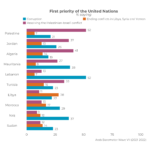When reflecting on the past 10 years, it’s clear to see that the Arab Spring is far from over. The popular uprisings in Sudan, Algeria, Iraq and Lebanon over the last couple of years, coupled with ongoing political and socio-economic tensions across the region, show that no political equilibrium has been found. However, waiting for another 2011 moment, as if nothing has changed, would be a mistake.
The political upheavals of 10 years ago have brought about far-reaching transformations to both the political landscape, as well as to the determinants of popular mobilization. Calls for political reform will have to take these transformations into consideration if they are to achieve real change.
The 2011 uprisings have had three main consequences: fear of state collapse, increased social polarization and the increasing importance of socio-economic demands. Any strategy for political change must address these factors in order to be successful.
‘Us or chaos’ – fear of state collapse
Restoring state institutions in countries where such institutions have either collapsed or have become ineffective, and protecting the state from collapse in other cases, are now important factors that could either hinder or strengthen any project for political change.
In 2011, the protesters who took to the streets in Tunisia, Egypt, Libya, Syria and Yemen had little concern about the risk of state collapse. While regimes tried to use the ‘us or chaos’ discourse to deter the popular protests – as in the case of Hosni Mubarak in Egypt – most of the protesters did not believe this threat. However, due to the subsequent wars in Syria, Libya and Yemen, this discourse has been gaining strength. Any calls for political change must therefore reassure people about safeguarding the role of the state in delivering to its citizens while also making clear the difference between a state and a regime.
Read full article at Chatham House

